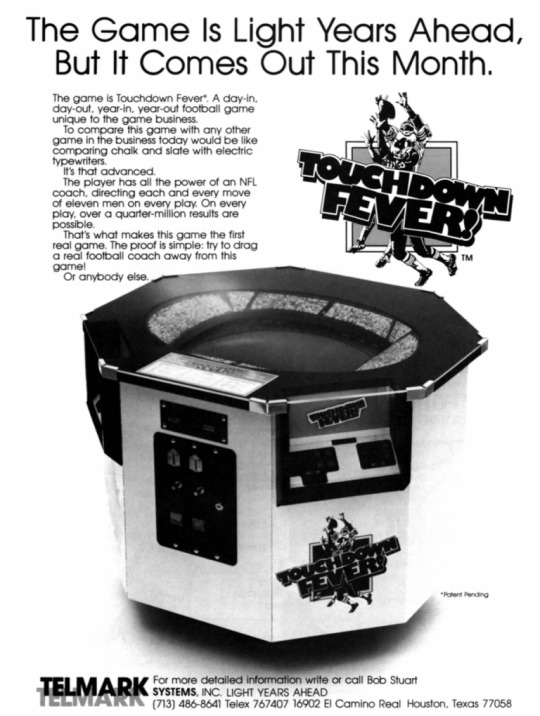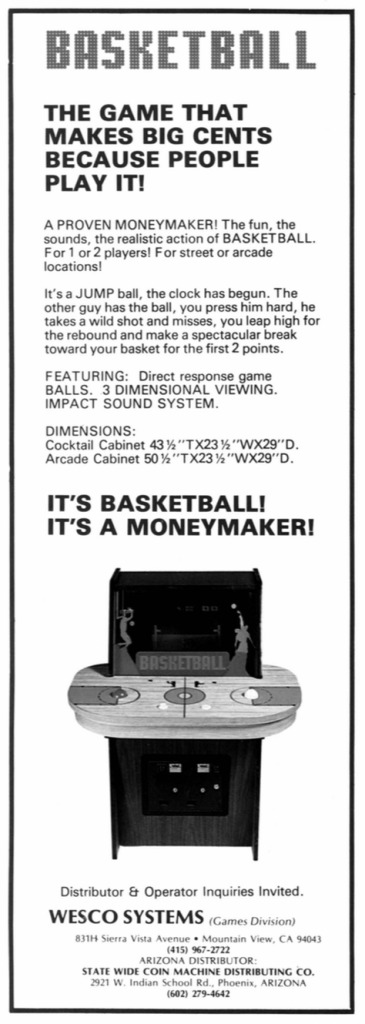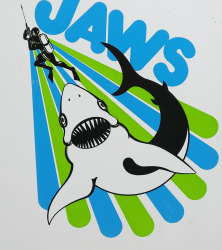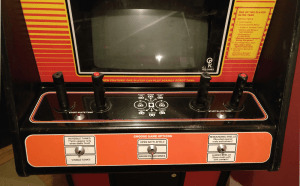Text
Allied Hesitation (1974)
An old collecting buddy forwarded me a sale post for an Allied Leisure Hesitation arcade video game cab from 1974. To be honest, I had never heard of nor seen Hesitation before. But, the picture sold me. Check out its Numitron scoring and unique cabinet design. Years ago I tried to track down Allied’s Zap, another game with Numitron scoring, and came up empty. I was stoked to see this turn up only an hour and a half away from home. These things don’t have feet, you know.

Made an offer on the game, but the seller was fielding offers from others. A week later he called and accepted. The seller told me that his brother had saved it in the early 80s after a Philly bar tossed the cabinet out on the curb. The two brothers held the game for the next 35 years or so, until I brought it back to Philadelphia.
Brief History of Allied Hesitation
Universal Research Laboratories in Elk Grove, IL had developed almost all of Allied’s prior circuit boards, and followed suit with Hesitation. Like most other pong video games, it’s a TTL1 game with no ROMs.

Allied Hesitation Serial No. 118
In 1974 “ball and paddle” sales screeched to a halt as the Pong2 fueled bubble of the year prior had burst. Most pong games from ’74 are hard to come by, and Hesitation is no exception. The cabinet has a serial no. stamped in the cabinet of 118. There couldn’t have been many more than 200 made. This Hesitation could possibly be the very last one in existence.
A warehouse fire delayed the Hesitation’s release until April 1974. Unfortunately by that time the public had had its fill of pong derivatives. Allied, along with other manufacturers, had saturated the market the year prior. In ’73 Allied’s sales had increased from $1.5 to $11.4 million. Games like Paddle Battle, Tennis Tourney, and Super Soccer made Allied Leisure a small fortune. 3
Allied also released a few other “ball and paddle” games with a similar cabinet form factor mounted on pinball legs. including Ric-o-chet, Knock Ball and Improbable. I’ve never seen a Knock Ball or Improbable outside of the flyer. Please forward me a pic, if you’ve come across one. Later on in 1975, Allied made their final ball and paddle games: Futsbol and Robot.

Numitron Scoring

Zap another Allied arcade video game with Numitron displays
Numitron vacuum tubes are sort of like Nixie’s poor sister. They utilize a seven segment display which makes them clearer to read. The tubes only require 5 volts making them ideal for use in an arcade cabinet. Very few bronze age arcade games use external displays for scoring. As a collector, it’s a real treat to see something like them in action.

Hesitation Numitron Display
Allied Hesitation Gameplay
Game play is a ball and paddle game with either 2 or 4 players. There are paddles on left and right for two player games. When playing four player, two additional paddles are placed top and bottom, and players are divided into teams of two: top and bottom vs left and right. There is an optional square block in the middle of the screen which can be turned off via a switch on the circuit board. One thing about this pong variant is that the ball “hesitates” after a scoring rebound. The length of hesitation is also adjustable.

Allied Hesitation Demo
I haven’t had time to gather four friends to take a proper video, so here’s a quick lil demo.
youtube
Additional Allied Hesitation Pics
Per request, I added some additional pics of the Allied Hesitation PCB, control panel and monitor.

Allied Leisure Hesitation PCB

Allied Hesitation Control Panel

I had to open up the underside to clean the paddle pots. Control Panel underside.

Allied Hesitation Monitor. Ball Brothers was an unusual choice considering Motorola, TEC, and Wells Gardner are what you typically see in arcade video games of the era
Allied Hesitation (1974) was originally published on Arcade 72
1 note
·
View note
Text
Telemark Touchdown Fever! and Wesco Systems Basketball
Here are a couple of late 70s sports videogames, Telemark Touchdown Fever! (1979) and Wesco Systems Basketball (1978). In over twenty years of collecting, I’ve never seen either arcade game outside of promotional materials. One wonders how Touchdown Fever! compares to Atari Football. Looking closely to the Wesco Basketball flyer, the monitor displays Basketball from the Atari 2600. The cabinet is similar to the cocktail style of Ramtek Hit Me. Please get in touch, if you have any leads for either game cabinet or part.


Telemark Touchdown Fever! and Wesco Systems Basketball was originally published on Arcade 72
1 note
·
View note
Text
Kurz Kasch Catalog
I came across this interesting Kurz-Kasch, Inc catalog of cards for their TF-650 test rig. While neither numbered nor dated like their other catalogs, it lists previously unknown Kurz Kasch cards. These cards are not listed in consequential catalogs. Perhaps they were vaporware. Click the image below to view the whole catalog, and my complete inventory of Kurz Kach cards are listed here.
Ramtek Star Cruiser 277
Atari Avalanche 286AB
Atari Sky Diver 289AB

Kurz-Kasch TF 650 catalog of program cards
Kurz Kasch Catalog was originally published on Arcade 72
1 note
·
View note
Text
Atari Shark Jaws (1975)
Maneater by PSE with its shark shaped fiberglass cabinet is a grail for many arcade collectors. Other collectors may have heard of US Billiards simply titled Shark. But, Shark Jaws (Atari, 1975) is the sleeper shark themed game desired by those in the know. Hoping to ride the coattails of the blockbuster film Jaws, all three were released within the same year.

Background
Rumor has it that Atari attempted to license an arcade video game based on the movie, but got nowhere with the studio. Nolan Bushnell decided to release the game anyway. Universal be damned! He created a phony company, Horror Games to shield Atari from lawsuits. All mentions of “Atari” were scrubbed from the cabinet art and manual and replaced with “Horror Games”. However, upon closer inspection the cabinet was clearly a Tank II leftover and the circuit board was marked “Atari”. Even more brash, the distributor flyer made clear this was an Atari release.
Avoid getting eaten by JAWS

Shark JAWS Side Art

Gene Lipkin, Atari’s VP of Marketing admits, “It took Universal only three days to figure out the game was Atari’s and there is no Horror Games” Atari Inc.: Business is Fun, 170">1
Along with Exidy’s Death Race, Shark Jaws was an early non-license bootleg video game based on a popular movie. Sneakily played up in its logo: a large typeface JAWS preceded by a tiny “shark”. Given Atari’s behavior, one has to wonder how worried they were about legal retribution from Universal.
Gameplay
The concept is rather simple: the player races against the clock to spear fish and avoid being eaten by JAWS. Considering the year of its release and being discrete logic and not processor based, the one-player gameplay is not bad. One clever aspect of Shark Jaws is how its sound passes through a reverb pedal giving the game an eerie underwater feel. When JAWS kills the diver, a blood-curdling scream echos in horror. While emulation is not a an exact match, you can play Shark Jaws on DICE, the Discrete Integrated Circuit Emulator.
Collector’s Take

Horror Games logo
It’s rather difficult to find a complete Shark Jaws arcade cabinet nowadays. Nolan Bushnell once claimed, “Shark Jaws was actually a huge success, we sold a couple thousand” The History of Atari: 1971-1977, 12">2 Counter to Bushnell’s boast, it is believed less than 1000 and likely closer to 500 cabinets were made All In Color For A Quarter">3. Of the known cabinets uncovered, their serial numbers fall below 500. For instance, my Shark Jaws has a serial number of 141. If you find one and are looking to sell or if you have knowledge of the designer, please get in touch!
At the Movies
Shark Jaws appeared in both the poorly received Sgt. Pepper’s Lonely Hearts Club Band and another cult classic fish disaster film Piranha.
Piranha (1978)

Sgt. Pepper’s Lonely Hearts Club Band (1978)

Arcade Game Play Demo
Watch this well filmed video of the game playing in an actual arcade cabinet.
youtube
Shirt!
Lastly, Shark Jaws is a favorite of mine from the period, and for a very limited time I’m offering a snazzy shirt based on the game.
1 note
·
View note
Text
Atari Ultra Tank (1978)
Ultra Tank History and Gameplay
Designed by Steve Bristow and developed by Lyle Rains, Tank (Kee Games, 1974) was the original tank combat video game. Each player has a birdseye view of a maze and drives a tank while avoiding mines and shooting at each other. This combat style differentiated the game in a world of pong and driving video games. It was a hit that spurred multiple sequels: Tank II, Tank 8, a bootleg Tankers, and ultimately Ultra Tank in 1978.
To keep earning money on location, operators hacked the original Tank circuit board enhancing the play. Ultra Tank incorporated these hacks into switchable options. In this writer’s opinion, the options are not very compelling as most times a player will select the same barricades, visible tanks, and guided missiles. Additionally, primitive AI made 1-player play possible by battling a “Robot” tank. Unfortunately, the robot is rather dumb and not too hard to beat.

Ultra Tank cabinet
Collector’s Take
As a collector, this game is well worth owning. Imbued in the archetypal Atari aesthetic, this uniquely shaped cab is a striking piece. Essentially Ultra Tank is the arcade version of the extremely popular Combat, but with improved sound, graphics and controls. Its gameplay is instantly recognizable to retro video game enthusiasts and anyone who grew up with an Atari 2600. Finding this bronze age gem could prove to be difficult as this version of Tank is extremely rare.
I obtained this cabinet years ago from another collector in trade, giving up a Vectorbeam Speed Freak to get this and an Elimination, the original version of Quadra Pong. How could I resist getting both the first and last Kee Game? Considering its age, the cabinet, bezel and control panel are in excellent shape. My buddy fixed the board and I capped the monitor.
Video Demos
Two different videos demos included. The first is edited creatively, while the second is shot straight.
youtube
View this post on Instagram
Ultra Tank (Kee Games, 1978) #arcade #atari #coinop #coinoperated #keegames #tank #combat #atari2600 #vintagegames #videogamecollection #oldschoolgaming #invisibletanks #bronzeage
A post shared by 70s Arcade pics (@arcade72) on May 29, 2017 at 3:28pm PDT
Coming out almost four years after the original Tank arcade game, it seemed like the public had its fill of tank games when Ultra Tank was introduced. At this point Kee Games had been fully absorbed by Atari and the game was released by Kee Games in name only. So, let’s hear it for Ultra Tank, the last Kee Game and the last in the Tank series.

Ultra Tank control panel
Atari Ultra Tank (1978) was originally published on Arcade 72
0 notes
Text
Sega Tracer (1976)
Sega Tracer released in 1976 was a compact version of its predecessor Bullet Mark. A bridge between electro-mechanical arcade (known as EMs) and video games, this discrete logic twin shooter has a number of noteworthy features. Using a mirror, the monitor is reflected from the bottom of the cabinet giving the illusion of the targets being further in the distance. The bezel displays the current score setting and large faux LED scoring. When shooting both twin tommy guns flash red LEDs in the tips and shake with a RAT-AT-TAT-TAT. This effect is really wild. Watch the video below the fold to get an idea.
Gameplay
Play starts with helicopter targets and progresses to submarines, bullseyes, and jet planes. Points per hit (and negative points per missed) target increase in each stage. Making it one of the earliest games with a vague concept of levels. If the player scores past a certain threshold, play continues starting again with helicopter targets. While optional IC chips were available at the time to change up the targets, the original target types were permanently screened on the metal instruction card.
Sega Tracer
Metal Instruction Plate
Tracer was marketed as having a smaller cabinet than competitors. This may be true in comparison to the two-piece Bullet Mark and some other EMs, yet numerous contemporaries like Midway Twin Pirate Gun and Chicago Coin Twin Rifle were considerably smaller. And, arcade video games of the time took up much much less floor space. This thing is a beast at 39″ wide and 64″ deep.
Early Sega video games are difficult to find in America. And Tracer is no exception, as the game is rare as heck. Unless someone knows otherwise, this cabinet is the only Tracer known to exist. It came out of the Pacific Northwest, and is in fantastic shape. The last Bullet Mark I knew of was in Ocean City, MD. Unfortunately, it was thrown out over 10 years ago. I know of none others around.
Good Things Come In Small Packages?
Video Demo
Here is a video I took of Sega Tracer in action. Check it out!
youtube
Alas, little to nothing is known about the history and development of Bullet Mark and Tracer. If you have any boards, parts or historical information about Tracer, please drop me a line.
Update
Came across this photo of a Sega Tracer back in the day.
Sega Tracer (1976) was originally published on Arcade 72
0 notes
Text
Exidy Crash (1979)
Picked up two Exidy Crash arcade cabinets a few months ago, and made the best of both. Still looking for a nicer control panel, but this will do for now. Incredibly the original operator had photos of one of these machines on location almost 40 years earlier. See below.

In years of collecting, seldom have I obtained documentation like this. Pictures of arcade games operated by small-time independent ops from back in the day are a treat to see. Doubly so, if it documents a newly added game to your collection.

Exidy Crash on location in the late 70s/early 80s
While the game was successful for its time, not much is known about its development. The generally held assumption is that Exidy Crash was a copy of Sega/Gremlin Head On. However, It very well could be the other way around. There are also a number of variants of Crash including Head On 2 and Space Chaser. If you have any information about Crash’s history, please contact me.
Another copy is this rarity: Atari Splash. My good buddy, Andy is in the process of restoring it. If you have an original Crash or Bandido joystick available, please contact him.

Found in the UK on an abandoned cruise ship, The Duke of Lancaster
Like a primitive Pac-Man, the object of Crash is to avoid the enemy car while collecting dots in a maze. A joystick and button to accelerate your car are one’s only controls. Watch local Philadelphia legend, Todd Tuckey demonstrate the game.
youtube
For its time, it’s a fun game. But, don’t take my word for it, play Crash in MAME
Exidy Crash (1979) was originally published on Arcade 72
0 notes